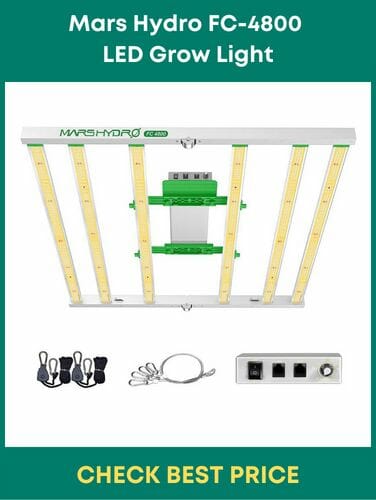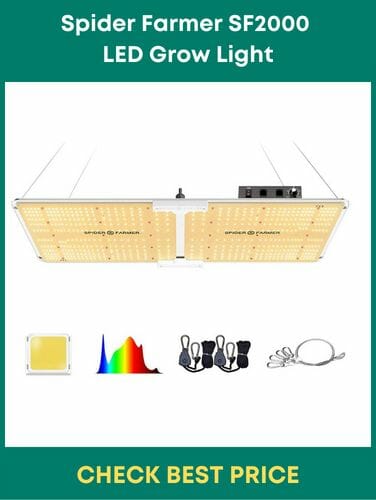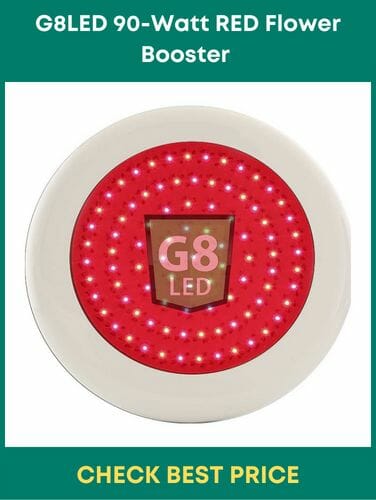
Whenever you buy grow lights for your plants, you must have come across terms like PPFD, PAR, DLI, and Wattage.
These are the terms that you need to understand carefully. Otherwise, you may have poor-quality grow lights, leading to average yield and poor growth of the plants overall.
So, what is it exactly, PPFD?
And how can you find to get the best and adequate PPFD grow lights for your plants?
Worry not!
Read along to learn everything about PPFD, PAR, DLI, and Wattage of grow lights and how much you need fair values for the best growth of your plants.
Let’s get started:
What Is PPFD, And Why Is It an Important Term Related To Grow Lights?
Contents

PPFD stands for Photosynthetic Photon Flux Density.
PPFD is the number of light photons that hit the surface of your plant in one second. So, it is the unit to measure how much light photos hits the plant.
The unit to measure PPFD (Photosynthetic Photon Flux Density) is μmols (micromoles).
With the PPFD, you measure how much light hits your plants once you turn them on.
Why is it important to measure this?
It is because the PPFD will eventually help you to keep your grow lights at an appropriate distance by hanging them so that your lights can illuminate most of the growing areas.
And now, you may ask why it is necessary for growth lights.
So the reason is when light travels from source to endpoint (surface of your plants in our case), it loses its strength.
You can observe the light strength by reading the PPFD chart, which we will discuss further.
Therefore, as the distance increases, the light strength or PPFD numbers decrease concerning the space.
It is essential to have adequate PPFD grow lights to provide better illumination when hung at a specific distance in all the grow spaces.
As you already know about PPFD, it is the perfect time to understand how much PPFD is required for your plants in different growth stages.
Let’s find out.
How Much PPFD Light Do Cannabis Plants Need During Flowering, Vegetation, And Seedling Stage?
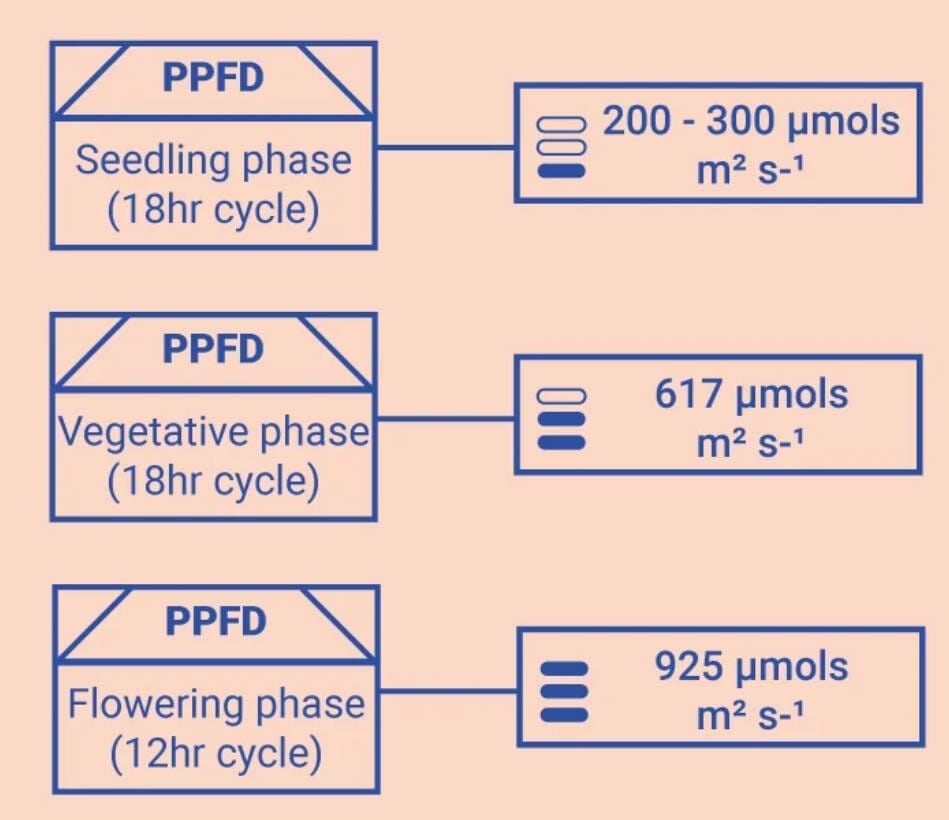
Once you know the importance of PPFD (Photosynthetic Photon Flux Density), the next step is understanding how much PPFD will be needed for your plants when growing.
However, in different growth stages, the requirement of PPFD may differ.
Therefore, I have broken down the need for PPFD in seedling, flowering, and vegetation stages so that you can understand it better.
Also, the numbers can vary in the calculation depending on your plant and garden size.
But here are the estimated PPFD that you need in different growth stages according to the light cycle.
Required PPFD In Seedling Phase
The seedling stage of a growing plant is a very crucial growth stage, and you need to provide optimal environmental conditions for better growth of the plant.
The PPFD requirement in the seedling stage goes around 200 to 300 micromoles with 18 hours of the daily light cycle.
It is the minimum light strength needed for your cannabis seedlings for moderate yield.
However, you can increase or decrease the PPFD value according to the plant type you are growing and consider some other factors in the later growth stage of the plant.
But in the case of seedlings, even if you want the highest yield from your plants, the initial PPFD requirement for the seedling growth stage remains 200-300 micromoles per second when you provide 18 hours of lighting and 6 hours of darkness.
This requirement is for the first three weeks of the seedling stage.
Required PPFD In Vegetative Phase
Once your plant matures, you can vary PPFD between the minimum and maximum range.
In the vegetative phase, the minimum light strength or PPFD needed is 306 micromoles, which can go as max as 617 micromoles.
In the vegetative stage, you will still be providing 18 hours of the light cycle with 6 hours of darkness, so that should not be an issue.
The whole day’s light requirement becomes 20 moles (mole is different from micromoles, and we will discuss later in this guide about moles or daily required light) in the cannabis vegetative phase.
That means your grow light needs to illuminate 308 micromoles per second in your grow area with 18 hours of on-mode.
However, some growers maximize the PPFD according to the need.
It is due to maximizing the cannabis yield, which can go up to 617 micromoles in the vegetative stage.
Required PPFD (Photosynthetic Photon Flux Density) In Flowering Phase
Like other crucial growth stages of a plant, the flowering phase is another critical stage in which you need to focus.
In the cannabis flowering phase, your grow lights need to illuminate 462 micromoles per second with 12 hours of lighting and 12 hours of dark mode to achieve 20 moles of light per day.
However, some growers prefer to increase their yield by increasing the light feed for their plants.
Therefore, some growers even increase the amount of light from 20 moles to 40 moles per day, which helps them get higher marijuana yield.
That means you need to double the dose of micromoles, i.e., from 308 PPFD to 616 PPFD during the vegetative phase and 463 PPFD to 925 PPFD during the flowering stage of your plant.
With the help of providing the right and adequate PPFD lighting to your plants, you can go for bigger yields and more output from your garden.
It is how you can ensure how much light your cannabis plants will need in the different growth stages.
How Much Light (PPFD) Do Auto-flowering Cannabis Plants Need?
PPFD requirements may differ in the case of auto-flowering marijuana plants.
Due to the long light days, there is no need for intense light for auto-flower cannabis plants as it is required for non-auto-flowering plants.
They get all the light due to the long working duration of light fixtures. Therefore, autoflowers quickly get the usable light amount, so there is no need to provide more light in the plant canopy.
It is because the non-auto flowering marijuana plants have 33% less time to absorb the light they need during the flowering stage.
Auto-flowering cannabis plants need 18 hours of light daily, so they have ample time to absorb the required light.
However, photoperiod cannabis plants are mostly switched to 12 hours of the light cycle; therefore, they have less time to absorb the daily required light amount.
That means, in the case of auto-flowering marijuana plants, you can keep the light intensity of 300 to 600 PPFD for the whole life of the auto-flowering cannabis plant.
How To Calculate PPFD Values?
Until now, you must know how much PPFD value for a grow light is essential. For example, you must optimize the light strength level or PPFD value according to different growth stages.
That means you need to provide adequate PPFD lighting to your cannabis plants.
However, before we dig into finding the best quality grow lights for providing adequate PPFD lighting, you must understand how to calculate the PPFD values or strength of light.
So let’s start with the basics first.
Taking 20 moles of light required per day for the cannabis plants, the total micromoles of lighting will be 20,000,000 micromoles for one day.
Then you need to divide this value by the amount of time you will keep your grow lights on.
Thus, take 18 hours of the light cycle when you will keep lights on for 18 hours in the vegetative stage and 6 hours rest.
So, 20,000,000 micromoles / 18 hours / 60 (min per hour) / 60 (sec per minute) = 308.6 micromoles.
308.6 micromoles will combine to make 20 moles of lighting for a light cycle of 18 hours per day for the vegetative phase.
Now, if you calculate this for 12 hours of the light cycle, 20,000,000 micromoles / 12 hours / 60 (min per hour) / 60 (sec per minute) = 463 micromoles of light.
Four hundred sixty-three micromoles of light are needed for 12 hours straight to make 20 moles of light feed for your plant during the flowering lighting phase.
Similarly, you can also calculate the 40,000,000 micromoles to know about making light feed for 40 moles per day.
It is how you can calculate the PPFD value for different growth stages of cannabis plants according to the daily light cycle in different phases, and the minimum required light feed, i.e., mole per day.
3 Best Grow Lights With Sufficient PPFD Output
Here are quick recommendations for growers who want a great LED grow light setup for their garden.
However, if you want to dig deep into the world of LED grow lights, I recommend reading How To Choose LED Grow Lights?
1. Mars Hydro FC-4800 LED Grow Light – Overall, The Best LED Grow Light
Best in the market.
With 2646 pcs of full spectrum diodes, get 2.8 umol/J high-efficiency output. Easy-to-install and detachable bars allow you uniformly adjust PPFD levels for your grow space in different growth stages.
Dimmable features, better heat dissipation, a highly efficient setup, and an IP65 waterproof rating make it the best choice.
2. Vivosun VS4000 LED Grow Lights – Best Branded LED Grow Light
You must already have heard Vivosun’s name, the brand that every grower trusts.
Vivosun VS4000 LED grow lights feature Samsung LM301 premium diodes and driver, which makes the lifespan of these lights longer. Get ready to use this lighting for multiple harvests.
Sunlike full spectrum light output with high efficiency and dimmable features make you get the most out of this grow light.
Low noise and low heat with warranty and 5-years after-sale service make your every penny worth the investment.
3. Spider Farmer SF2000 LED Grow Light – Budget-Friendly Grow Light
Want a budget-friendly, but premium grow light?
Buy Spider Farmer SF2000 LED grow lights!
Samsung LM301B diodes and daisy chain full spectrum light setup allow you to get the best light setup for your indoor garden under a budget price segment.
Best for a 3 x 3 grow tent, the light setup has 200W consuming less energy and providing high output.
How To Increase Or Decrease The Intensity (PPFD) Of My Current Grow Lights?
If you have not bought any grow light, you can follow the above steps to get a great light setup, but if you already have a light setup, you may think of increasing or decreasing the light strength (PPFD) according to your need.
The good news is that it is possible to increase or decrease the light intensity or PPFD of your current grow light.
There are two ways to increase or decrease the light intensity on your plants. These are:
- By Adjusting Height
- By Dimmer Function (If your light setup has one)
Let’s look at how you can increase or decrease the light setup in these two ways.
By Adjusting Height
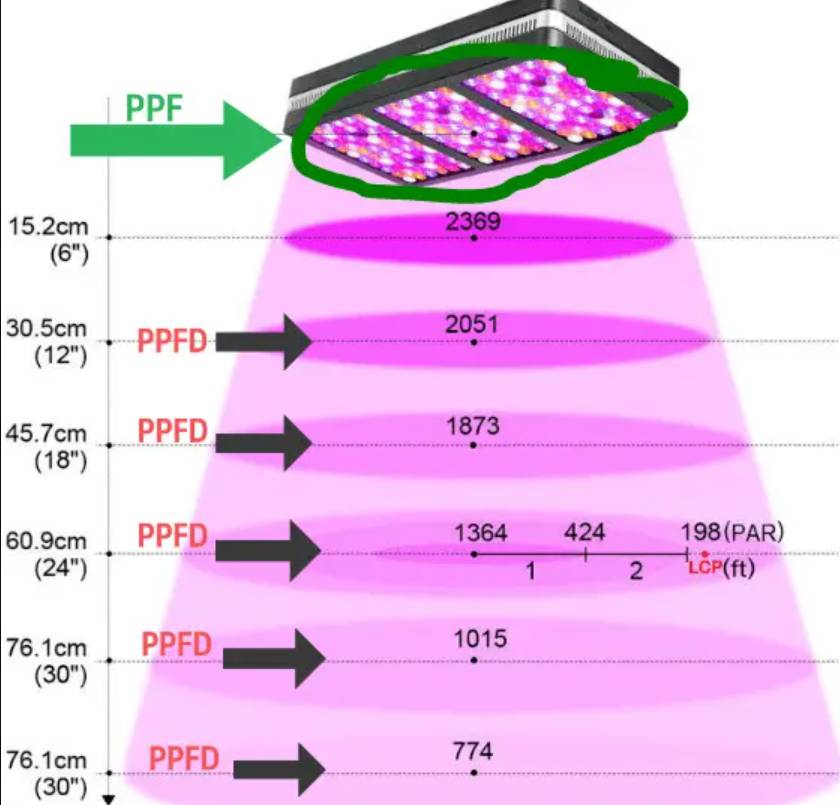
It is the obvious method to increase or decrease the PPFD or light intensity for your cannabis plants.
As mentioned earlier, PPFD is valuable for your grow light because it helps you set the light up at an appropriate distance from your plants to give them the required light during different growth phases eventually.
Therefore, if you want to increase the light intensity, you can adjust the hang height of your grow light.
The higher the grow lights will hang, the larger the area it will cover, but at the same time, the light strength will be weaker.
And if you want to increase the light intensity, you can lower the light hangs, and now the light will be more intense on your plants.
However, as you lower the height of the grow lights, it will cover a comparatively smaller area than before.
Apart from this, if you want more height and light intensity precision, you can follow the Physics’ Inverse Square Law.
According to it, If you keep your grow lights at a distance, say 1000 micromoles at 16 inches, then every time you double the height, the light intensity will be reduced by 75%.
That means if you consider 1000 micromoles of light setup situated at 16 inches height, then by doubling the size, i.e., at 32 inches, the light output you will get will be reduced to 250 micromoles only.
This law and understanding make it easier to calculate the light intensity for your grow light setup at different heights when you don’t have any references.
However, if you already have light intensity at a specific height (usually provided by the light manufacturers), you can easily calculate the light intensity for your required size.
Thus you can easily set up the light system to increase or decrease the light intensity according to your need.
By Dimmer
To decrease the light strength or increase it according to your need, nowadays, most LED grow light setups come with a dimmer.
That dimmer allows you to increase the light strength or decrease it when needed quickly.
This feature is now ubiquitous, and you can easily get all these features from grow lights of Vivosun, and Spider Farmer grow lights.
So with the help of a dimmer, you can control the light intensity for your plants.
How To Measure Grow Light Intensity (PPFD)?
Now you have set up your best grow light in your garden.
But you are concerned with the output of this light setup?
Or simply if you want to measure the grow light intensity or PPFD level for your existing grow light setup, then you need this PPFD meter:
Apogee Digital PPFD Meter For Indoor Grow Lights
This digital PPFD meter is all you need to measure the PPFD levels for your grow light setup. This digital meter can measure if the light is too intense for your cannabis plants.
The best part of this digital tool is that it measures precisely the wavelengths you want on your plant.
It measures from 390nm to 690nm wavelengths.
The Apogee MQ 500 digital PPFD meter is tested to work perfectly with the LED grow lights, HPS (High-Pressure Sodium), Ceramic Metal Halide, and MH (Metal Halide) grow lights.
Therefore, you can use this meter for most of the grow lights in your grow area.
However, the Apogee PPFD meter is a bit expensive but worth the investment and far better than most of the cheaper meters, which are less accurate.
The cheaper tools give less accuracy while converting Lux to PPFD.
What If Your Grow Lights Don’t Have Enough PPFD Level?
Let’s be honest here:
Cheaper LED grow lights are not worth buying!
But what if you have fallen for one and want to improve the light intensity?
Don’t worry; we have a solution for you!
If your existing grow light setup does not produce enough PPFD output to fulfill the light requirement of plant growth, you can go for a bloom booster.
Cheaper grow lights can find it challenging to provide 20 moles per day output, but adding a bloom booster can make it easier for your existing grow lights.
Bloom booster is an additional lighting component that will “boost” the PPFD levels in your grow area.
Therefore, you don’t need to throw your existing grow lights or buy a new light setup. With bloom booster, you can make your significant investment in grow light worth it.
Here is the best bloom booster that we found online:
G8LED 90-Watt RED Flower Booster LED Grow Light
Key Benefits:
- Add this and boost the PPFD levels or light intensity in your grow room
- A dense network of diodes to get the required output
- With a high PAR light (Photosynthetically active radiation) value of 770 micromoles/m2/s
- One flowering booster is needed per 8-10 square feet of growing area
- Get a response from your plants within one week
- Recommended by light manufacturers
Buy This PPFD Booster Now!
What Is Photosynthetically Active Radiation (PAR) And Daily Light Integral (DLI)?
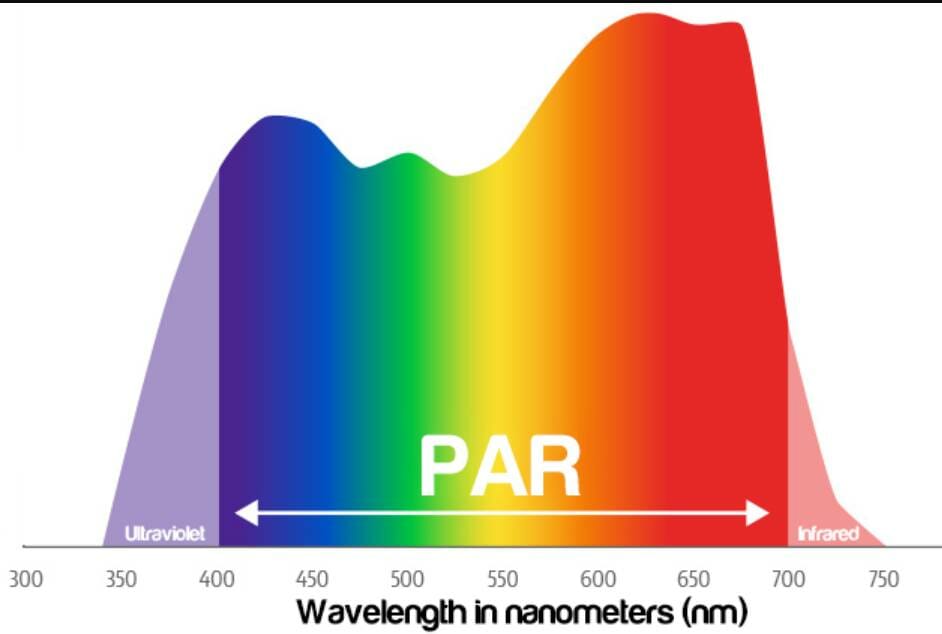
Apart from PPFD, other terms, such as PAR and DLI, are used when buying grow lights for plants.
PAR stands for Photosynthetically Active Radiation. And it is the range of light wavelengths that makes photosynthesis in plants.
The range of Photosynthetically Active Radiation PAR is from 400 to 700 nanometers.
Furthermore, Daily Light Integral, or DLI, is the amount of light cannabis plants need each day to produce marijuana.
The units for DLI (Daily Light Integral) are moles and micromoles (one-millionth of one mole), and we have already discussed these terms in this guide.
What DLI Does Cannabis Require?
So, apart from Photosynthetically active radiation (PAR), how much DLI with modern LED grow lights are required?
As said before, DLI (Daily Light Integral) is simply adding PPFD numbers and adding them to make it a one-day dose for your cannabis plants.
So vegetable-bearing crops need between 20 to 50 moles of light per day. And it also implies the cannabis plants.
Some growers also increase the light feed from 20 to 40 moles daily to maximize their garden yield.
What Is Wattage And How Much Wattage Is Sufficient For Your Plants?
Wattage is the essential factor you need to consider before buying a grow light.
The actual wattage of your grow lights is determined by knowing how many watts your light setup is consuming from the outlet.
And knowing the correct wattage for your cannabis plants also help you get the most out of your investment.
Otherwise, with the wrong purchase, you may be paying more for your electricity bill than your actual need.
However, with the advancement of LED grow lights, light setups are becoming power efficient, and with low power consumption, they provide high power output.
For instance, if you buy a “2000-Watt LED Grow Light, ” your light setup has two hundred of 10-watt LED chips, which is why it is called 2000-watt.
But the power consumption from the wall for this light setup will be around 500 to 600 watts.
And this is the actual wattage you need to look at while buying a grow light, along with the wattage of LED bulbs.
Coming to the sufficient wattage value for your plants, you need to calculate it on your own depending upon the size of grow tent or grow room and the number of plants you are growing.
You can read our step-by-step guide on How To Calculate Wattage For Your Cannabis Plants?
FAQs
How much PPFD is too much?
If the Photosynthetic Photon Flux Density (PPFD) levels exceed 2000 micromoles indoors, it is more likely to be too much. Therefore, too much light or PPFD can negatively impact the yield in extreme cases.
What light intensity is best for flowering?
Up to 500 to 1000 PPFD in the flowering stage is usually followed. But some growers also opt for going till 1100 to 1500 PPFD under the flowering phase to increase the yield.
Therefore, you must practice the best range according to your needs and garden type.
How much PPFD do my plants need?
As mentioned above, the PPFD requirement for the seedling stage is around 100 to 200 micromoles, which can increase to 200 to 500 micromoles in the vegetative stage and up to 900 micromoles in the flowering stage.
However, you are recommended to define your range of PPFD according to the need and yield requirement.
Should I increase light intensity during flowering?
Many growers decrease the DLI (Daily Light Integral) during the flowering stage and increase the light intensity. The photoperiod should be 12 hours while in the flowering phase; however, this can go to 18 hours of the light cycle under the vegetative stage.
Final Words
With sufficient PPFD intensity for your cannabis plants, you can have better output and yield, therefore, it is one of the essential parts when choosing a grow light.
Finally, now you know multiple terms when used concerning grow lights. And on top of that, you also got some grow light recommendations for providing sufficient PPFD to your plants.
Initially, with grow light, you need to aim for 20 moles per light session which you can increase up to 40 moles if you want to maximize yield.
But above all, remember to provide ample lighting to get the most out of your garden.

